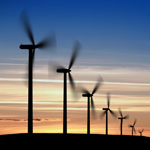
North Hoyle offshore wind farm
While this blog frequently focusses on wind power reporting in national-level newspapers, the regional-level or local newspaper does not get as much attention as it perhaps merits.
Last month I was in North Wales – a coastline which is home to the UK’s first large scale offshore wind farm called North Hoyle. It currently has one other operating offshore wind farm – Rhyl Flats, and a massive development is underway further out to sea at Gwynt y Môr offshore wind farm which, when completed in 2013, is set to provide electricity to cover nearly one-third of homes in Wales.
There is, of course, local opposition. On this particular stretch of coastline the opposition group is called Save Our Scenery – slightly ironic given that the new offshore farm is 18 km offshore and will be frequently out of vision thanks to the often dense banks of Welsh cloud.
 A good newspaper is “a nation talking to itself”, playwright Arthur Miller once said. If so, then the conversation being played out on the pages of the agenda-setting Irish Times shows a nation that has not made up its mind on its energy future.
A good newspaper is “a nation talking to itself”, playwright Arthur Miller once said. If so, then the conversation being played out on the pages of the agenda-setting Irish Times shows a nation that has not made up its mind on its energy future.
Irish wind energy recently made the headlines with the announcement that a 5000MW wind farm was planned for the midlands of the country, with the UK market in mind. ‘Ireland to the rescue – Plan to flow 3GW of Irish onshore wind power to the UK via consented grid connection can help Britain reach its 2020 targets’ said the cover story of energy magazine Recharge.

Denise Bode, AWEA
Newsrooms, websites and social media have been enthusiastically reporting this past week that the United States wind power sector now has installed at least 50 gigawatts of electric generating capacity.
Chuck Grassley, a Republican Senator from Iowa, said in an American Wind Energy Association (AWEA) press release that attaining 50 GW of wind energy is a milestone for the US sector. “This milestone for wind-energy production marks continued success for this clean, renewable and domestically produced energy source,” Grassley said.
Frank Lucas, a Republican Representative from Oklahoma, also called the new level of installed wind power a milestone: “It is amazing that 50,000 megawatts of our nation’s power is generated from clean and affordable wind energy,” Lucas said. “This is a very big milestone for the wind industry.”
 Much of the emphasis on green living today is all about scaling down: own a bike and not a SUV, for example. But when it comes to wind turbines a new study has found that the reverse is true: bigger turbines are better for the environment.
Much of the emphasis on green living today is all about scaling down: own a bike and not a SUV, for example. But when it comes to wind turbines a new study has found that the reverse is true: bigger turbines are better for the environment.
Since the founding of EWEA some 30 years ago (read more about our 30th anniversary here and look out for a special edition of Wind Directions magazine in September) turbine technology has been transformed. In 1982, turbine manufacturers were building 55kW turbines; today typical onshore turbines are around 3 MW, with the largest onshore turbines reaching a powerful 7 MW.

Global Wind Day 2012 in Estonia
By Tuuliki Kasonen, General Manager of Estonian Wind Power Association
According to a survey carried out by the Estonian Ministry of the Environment, Estonians consider wind power and biomass to be the best energy sources due to their economic, environmental and energy security benefits. 95% of the respondents considered wind power and 81% biomass as the most environmentally friendly way to produce energy.
The majority of the respondents found that the most important aspect of generating energy is environmental friendliness, followed by low cost and energy independence.








 Comments
Comments



